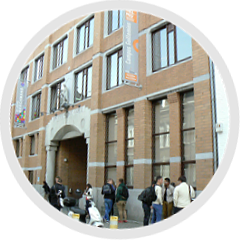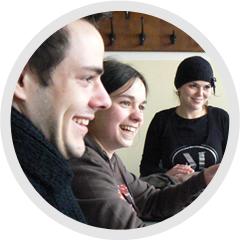| Titre : | Computer organization and design : the hardware-software interface | | Type de document : | Livres, articles, périodiques | | Auteurs : | David A. Patterson (1947-....), Auteur ; John L. Hennessy (1952-....), Auteur | | Mention d'édition : | 5th edition | | Editeur : | Oxford : Morgan Kaufmann | | Année de publication : | 2014 | | Importance : | XXII-575-[194] p. | | Format : | 24 cm | | ISBN/ISSN/EAN : | 978-0-12-407726-3 | | Langues : | Anglais (eng) | | Mots-clés : | Architecture informatique | | Index. décimale : | 004.2 Architecture d'ordinateur | | Résumé : | The fifth edition of Computer Organization and Design-winner of a 2014 Textbook Excellence Award (Texty) from The Text and Academic Authors Association-moves forward into the post-PC era with new examples, exercises, and material highlighting the emergence of mobile computing and the cloud. This generational change is emphasized and explored with updated content featuring tablet computers, cloud infrastructure, and the ARM (mobile computing devices) and x86 (cloud computing) architectures.
Because an understanding of modern hardware is essential to achieving good performance and energy efficiency, this edition adds a new concrete example, "Going Faster," used throughout the text to demonstrate extremely effective optimization techniques. Also new to this edition is discussion of the "Eight Great Ideas" of computer architecture.
As with previous editions, a MIPS processor is the core used to present the fundamentals of hardware technologies, assembly language, computer arithmetic, pipelining, memory hierarchies and I/O.
Instructors looking for fourth edition teaching materials should e-mail textbook@elsevier.com.
- Winner of a 2014 Texty Award from the Text and Academic Authors Association
- Includes new examples, exercises, and material highlighting the emergence of mobile computing and the cloud
- Covers parallelism in depth with examples and content highlighting parallel hardware and software topics
- Features the Intel Core i7, ARM Cortex-A8 and NVIDIA Fermi GPU as real-world examples throughout the book
- Adds a new concrete example, "Going Faster," to demonstrate how understanding hardware can inspire software optimizations that improve performance by 200 times
- Discusses and highlights the "Eight Great Ideas" of computer architecture:
* Performance via Parallelism;
* Performance via Pipelining;
* Performance via Prediction;
* Design for Moore's Law; Hierarchy of Memories;
* Abstraction to Simplify Design;
* Make the Common Case Fast;
* and Dependability via Redundancy
- Includes a full set of updated and improved exercises | | Note de contenu : | Parce que la compréhension du matériel moderne est essentielle pour obtenir de bonnes performances et une efficacité énergétique, cette édition ajoute un nouvel exemple concret, "Going Faster", utilisé dans tout le texte pour démontrer des techniques d'optimisation extrêmement efficaces. Une autre nouveauté de cette édition est la discussion sur les «Huit grandes idées» de l'architecture informatique.
Comme pour les éditions précédentes, un processeur MIPS est le noyau utilisé pour présenter les principes fondamentaux des technologies matérielles, du langage d'assemblage, de l'arithmétique des ordinateurs, du pipelining, des hiérarchies de mémoire et des E / S. |
Computer organization and design : the hardware-software interface [Livres, articles, périodiques] / David A. Patterson (1947-....), Auteur ; John L. Hennessy (1952-....), Auteur . - 5th edition . - Oxford : Morgan Kaufmann, 2014 . - XXII-575-[194] p. ; 24 cm. ISBN : 978-0-12-407726-3 Langues : Anglais ( eng) | Mots-clés : | Architecture informatique | | Index. décimale : | 004.2 Architecture d'ordinateur | | Résumé : | The fifth edition of Computer Organization and Design-winner of a 2014 Textbook Excellence Award (Texty) from The Text and Academic Authors Association-moves forward into the post-PC era with new examples, exercises, and material highlighting the emergence of mobile computing and the cloud. This generational change is emphasized and explored with updated content featuring tablet computers, cloud infrastructure, and the ARM (mobile computing devices) and x86 (cloud computing) architectures.
Because an understanding of modern hardware is essential to achieving good performance and energy efficiency, this edition adds a new concrete example, "Going Faster," used throughout the text to demonstrate extremely effective optimization techniques. Also new to this edition is discussion of the "Eight Great Ideas" of computer architecture.
As with previous editions, a MIPS processor is the core used to present the fundamentals of hardware technologies, assembly language, computer arithmetic, pipelining, memory hierarchies and I/O.
Instructors looking for fourth edition teaching materials should e-mail textbook@elsevier.com.
- Winner of a 2014 Texty Award from the Text and Academic Authors Association
- Includes new examples, exercises, and material highlighting the emergence of mobile computing and the cloud
- Covers parallelism in depth with examples and content highlighting parallel hardware and software topics
- Features the Intel Core i7, ARM Cortex-A8 and NVIDIA Fermi GPU as real-world examples throughout the book
- Adds a new concrete example, "Going Faster," to demonstrate how understanding hardware can inspire software optimizations that improve performance by 200 times
- Discusses and highlights the "Eight Great Ideas" of computer architecture:
* Performance via Parallelism;
* Performance via Pipelining;
* Performance via Prediction;
* Design for Moore's Law; Hierarchy of Memories;
* Abstraction to Simplify Design;
* Make the Common Case Fast;
* and Dependability via Redundancy
- Includes a full set of updated and improved exercises | | Note de contenu : | Parce que la compréhension du matériel moderne est essentielle pour obtenir de bonnes performances et une efficacité énergétique, cette édition ajoute un nouvel exemple concret, "Going Faster", utilisé dans tout le texte pour démontrer des techniques d'optimisation extrêmement efficaces. Une autre nouveauté de cette édition est la discussion sur les «Huit grandes idées» de l'architecture informatique.
Comme pour les éditions précédentes, un processeur MIPS est le noyau utilisé pour présenter les principes fondamentaux des technologies matérielles, du langage d'assemblage, de l'arithmétique des ordinateurs, du pipelining, des hiérarchies de mémoire et des E / S. |
|  |


 Faire une suggestion Affiner la recherche
Faire une suggestion Affiner la rechercheComputer organization and design / David A. Patterson






